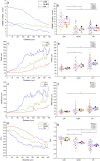Investigating the Microchannel Architectures Inside the Subchondral Bone in Relation to Estimated Hip Reaction Forces on the Human Femoral Head
- PMID: 34023913
- PMCID: PMC8484212
- DOI: 10.1007/s00223-021-00864-x
Investigating the Microchannel Architectures Inside the Subchondral Bone in Relation to Estimated Hip Reaction Forces on the Human Femoral Head
Abstract
The interplay between articular cartilage (AC) and subchondral bone (SB) plays a pivotal role in cartilage homeostasis and functionality. As direct connective pathways between the two are poorly understood, we examined the location-dependent characteristics of the 3D microchannel network within the SB that connects the basal cartilage layer to the bone marrow (i.e. cartilage-bone marrow microchannel connectors; CMMC). 43 measuring points were defined on five human cadaveric femoral heads with no signs of osteoarthritis (OA) (age ≤ 60), and cartilage-bone cylinders with diameters of 2.00 mm were extracted for high-resolution scanning (n = 215). The micro-CT data were categorized into three groups (load-bearing region: LBR, n = 60; non-load-bearing region: NLBR, n = 60; and the peripheral rim: PR, n = 95) based on a gait analysis estimation of the joint reaction force (young, healthy cohort with no signs of OA). At the AC-SB interface, the number of CMMC in the LBR was 1.8 times and 2.2 times higher compared to the NLBR, and the PR, respectively. On the other hand, the median Feret size of the CMMC were smallest in the LBR (55.2 µm) and increased in the NLBR (73.5 µm; p = 0.043) and the PR (89.1 µm; p = 0.043). AC thickness was positively associated with SB thickness (Pearson's r = 0.48; p < 1e-13), CMMC number. (r = 0.46; p < 1e-11), and circularity index (r = 0.61; p < 1e-38). In conclusion, our data suggest that regional differences in the microchannel architecture of SB might reflect regional differences in loading.
Keywords: Bone micro-CT; Bone microarchitecture; Cartilage-bone marrow microchannel connectors; Gait analysis; Human femoral head; Subchondral bone.
© 2021. The Author(s).
Figures







Similar articles
-
Changes of the subchondral bone microchannel network in early osteoarthritis.Osteoarthritis Cartilage. 2023 Jan;31(1):49-59. doi: 10.1016/j.joca.2022.10.002. Epub 2022 Oct 12. Osteoarthritis Cartilage. 2023. PMID: 36243309
-
The effect of osteoarthritis on the regional anatomical variation of subchondral trabecular bone in the femoral head.Clin Biomech (Bristol). 2015 Jun;30(5):418-23. doi: 10.1016/j.clinbiomech.2015.03.017. Epub 2015 Mar 24. Clin Biomech (Bristol). 2015. PMID: 25823901
-
Microstructural alterations of femoral head articular cartilage and subchondral bone in osteoarthritis and osteoporosis.Osteoarthritis Cartilage. 2013 Nov;21(11):1724-30. doi: 10.1016/j.joca.2013.06.030. Epub 2013 Jul 4. Osteoarthritis Cartilage. 2013. PMID: 23831666
-
Modeling knee osteoarthritis pathophysiology using an integrated joint system (IJS): a systematic review of relationships among cartilage thickness, gait mechanics, and subchondral bone mineral density.Osteoarthritis Cartilage. 2018 Nov;26(11):1425-1437. doi: 10.1016/j.joca.2018.06.017. Epub 2018 Jul 26. Osteoarthritis Cartilage. 2018. PMID: 30056214
-
[Comparative histomorphometry of subchondral bone density and articular cartilage thickness in the tibial head in early human arthritis].Z Orthop Ihre Grenzgeb. 1995 Jul-Aug;133(4):291-302. doi: 10.1055/s-2008-1039795. Z Orthop Ihre Grenzgeb. 1995. PMID: 7571794 Review. German.
Cited by
-
Differential effects of alendronate on chondrocytes, cartilage matrix and subchondral bone structure in surgically induced osteoarthritis in mice.Sci Rep. 2024 Oct 23;14(1):25026. doi: 10.1038/s41598-024-75758-7. Sci Rep. 2024. PMID: 39443554 Free PMC article.
-
Increased vascularization of the subchondral region in human osteoarthritic femoral head in the elderly.Histochem Cell Biol. 2025 Mar 23;163(1):39. doi: 10.1007/s00418-025-02365-6. Histochem Cell Biol. 2025. PMID: 40122994 Free PMC article.
-
Extracellular Vesicles Allow Epigenetic Mechanotransduction between Chondrocytes and Osteoblasts.Int J Mol Sci. 2021 Dec 10;22(24):13282. doi: 10.3390/ijms222413282. Int J Mol Sci. 2021. PMID: 34948080 Free PMC article.
-
Microarchitecture Alternations of Osteochondral Junction in Patients with Osteonecrosis of the Femoral Head.Calcif Tissue Int. 2024 Feb;114(2):119-128. doi: 10.1007/s00223-023-01153-5. Epub 2023 Nov 30. Calcif Tissue Int. 2024. PMID: 38036697
-
The Interaction between microRNAs and the Wnt/β-Catenin Signaling Pathway in Osteoarthritis.Int J Mol Sci. 2021 Sep 13;22(18):9887. doi: 10.3390/ijms22189887. Int J Mol Sci. 2021. PMID: 34576049 Free PMC article. Review.
References
Publication types
MeSH terms
Grants and funding
LinkOut - more resources
Full Text Sources
Other Literature Sources
Medical
Research Materials

